
Making rebrand work for you in three(ish) steps
Rebrands can be daunting. Concerns over timings, budgets and engaging external agencies can make it feel either completely out of reach, or at the least hard to do ‘properly’.
But the truth is there is no one-size-fits-all approach to rebranding. And any size organisation with any budget can successfully rebrand.
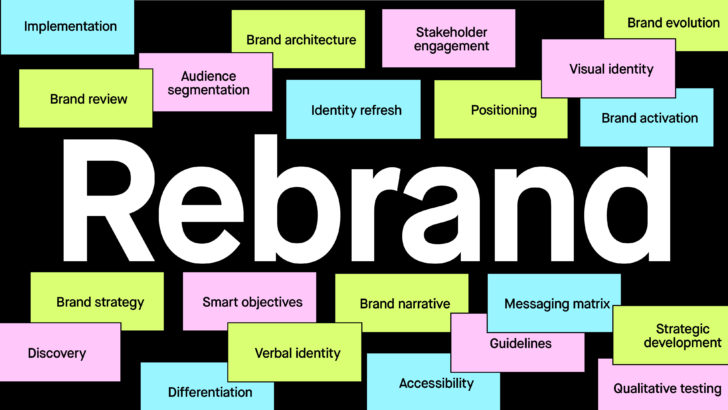
Let’s start with the basics. 'Rebrand', it’s a pretty simple word, but it can become a complex subject quite quickly.
Do we mean rebrand, brand review, identity refresh, positioning, visual identity, brand evolution, brand strategy, verbal identity, brand narrative? What about audience segmentation, stakeholder engagement, return on investment, discovery, SMART objectives, guidelines, qualitative testing? Not to mention implementation, brand activation, brand architecture, differentiation, accessibility, messaging matrices. The list goes on and on and on.
Something that is quite simple in theory can quickly become swamped in terminology and processes. This article is not about claiming that rebrands are simple. They can be very complex, and they’re rarely easy or straightforward. But if we can strip away some of the noise and try to think about the rebranding process a bit differently, we can make it more digestible, accessible and easier to achieve.

What needs to change?
We can demonstrate this thought process but looking at what actually needs to change. We’ve already established that there are a lot of moving parts in a rebrand. However, when we drill down into it, we can usually strip it back to three main areas:
Brand strategy – Our story
Verbal identity – How we sound
Visual identity – How we look
Once we start to establish what parts of our brand need to change, we can start to think about the scale of change that's required. Is it a very small adjustment, or do we need to make some more fundamental, large scale changes to achieve our objectives?
By thinking about rebrand in these simpler terms, we can not only make it feel a little less daunting, but also adjust our approach to work within our means.
Which brings us to ‘three-ish’ steps to make rebrand work for you.
These steps are Plan, Review and Do – plus a little cheeky review at the end, which is why there’s the ‘ish’.

Step 1 – Plan
Thorough planning is super-important in any rebrand project. Understanding why you need to rebrand is essential (what problem are you trying to solve) but also questioning whether brand is going to be the best thing to address it.
If the answer is yes, the next stage is clearly defining the core objectives for the project. Are we trying to increase fundraising? Is it about brand awareness? How do we measure success?
Defining objectives at the outset helps make sure we stay on track when when we get deeper into the process.
Take the time to map all these things out, thinking about timelines – who’s doing what and when – to make sure you start off in the right way.
The planning phase is also usually the point that conversations are taking place around whether or not to engage an agency. Which brings us to our first myth.

Myth 1: Doing brand development ‘properly’ means working with an external agency.
You might be thinking that as an agency, we're obviously going to bang that drum but we really want to try and give a balanced assessment here.
The decision of whether you should employ an agency or not can feel like a really big all-or-nothing moment in the rebrand process. You either hit one button or the other. But it doesn’t really have to be that way.
Don’t get me wrong, working with an agency can absolutely be the right decision for a lot of organisations. They can provide external perspectives, they have the ability to sit somewhat outside of the internal politics, they can manage the process and they bring a wealth of expertise and experience. But it might not be possible or right for all organisations.
If you’ve got budget or time constraints, it might mean that doing some or all of the work internally is going to be the right approach for you. There’s really no one right way to develop a brand, but there are some things you can start to think about that might point you in the right direction.
Asking things like whether you need an external perspective, understanding what your budget constraints are, whether you can afford it, and also having a really frank discussion about whether you can commit the time and headspace internally to manage the project. These can all help steer your decision.
And if you do engage an expert, tailor it to your resources. A freelancer or a studio for a very specific part of the project might be the way to go if budgets and timings are tight. This was the case with our work with North London Hospice when they approached us to work with them on their brand development.
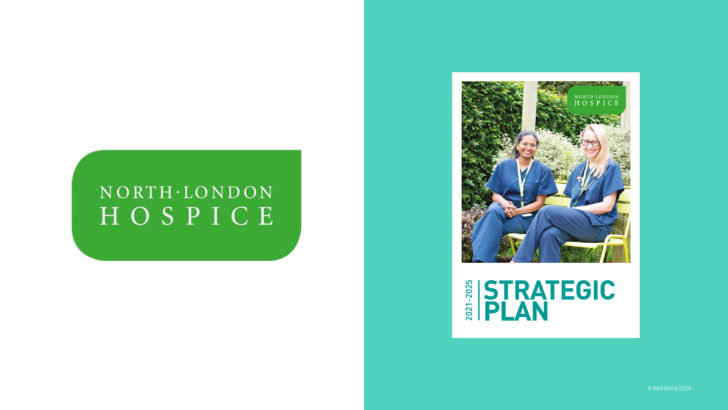
Laying good foundations
Before engaging an agency, North London Hospice had already undertaken a lot of the planning phase to identify the reasons they felt they needed to develop their brand. For them, this was primarily around a new strategic plan that had identified brand as a key driver.
They’d also identified some other reasons why now was the right time. They had low brand awareness with the wider population they serve, and the lack of a consistent identity meant all their shops – a key touch point for them – all looked different. As well as figuring out the 'why', they’d also taken planning a step further to start thinking about those objectives.
The project had one key objective: to create a refreshed brand identity to support their strategic ambitions. We would come back to this throughout the project to make sure we were on track.
They’d also started to get more detailed and break down this key objective into some clearly identifiable areas; creating a brand that’s clearly recognisable, that could be used across the business, is easy to use, that could increase public understanding, raise their brand profile and, in time, provide a base for effective fundraising.
Having that more granular approach to objectives is useful, particularly when we get into the detail of a brand development project. You have some really clear reference points that you can go back to and make sure that what you’re doing is actually answering what you set out to achieve.

Step 2 – Review
When we’ve planned and pinned down our objectives, the next stage is to review. This is all about taking stock of what we have at the moment, but also anticipating where we need to get to. This can be a really large piece of work, but again, we want to try to strip it back to the essentials.
If we only ask these three questions below as a minimum, we can get a pretty good idea of what’s working at the moment.
‘What do we have?’
This is usually referred to as a brand audit, but essentially involves looking at everything that makes up our brand. From our name, our logo, graphic assets, all the way through to our outputs, whether that’s stationary, socials and websites, we want to have sight of everything that our brand touches.
‘What needs to change?’
Taking all those things we’ve listed and marking them against the objectives that we defined in our planning stage, we can see whether something is working well and should be retained, whether it needs to evolve, or whether we just need to change it entirely.
‘What is going to work?’
This is all about talking to our audiences and trying to get an understanding of where we’re trying to get to. To find out what they know about us today, but also what they might expect from us in the future. This brings us on to our second myth.

Myth 2: Audience research is expensive and needs to be extensive.
Audience research can be both these things, but it doesn’t have to be. Just talking to people can be really valid audience research. It might be in the form of sending out a newsletter asking some opinions, or even just talking to people face to face and asking one or two really pointed questions. A little insight can be better than none.
This review phase is where our work with North London Hospice really began – by doing that review of all their outputs, primarily from a visual identity perspective. It revealed a real lack of consistency and substance in the identity. This was where the largest chunk of work was required.
However, from a strategy point of view, they did have something to work with. We hadn’t been commissioned to develop a brand strategy as part of this project. Instead, they developed a vision, a purpose and values internally as part of their organisational strategy. While it didn’t answer all the strategic questions, it did give us a foundation to build on.
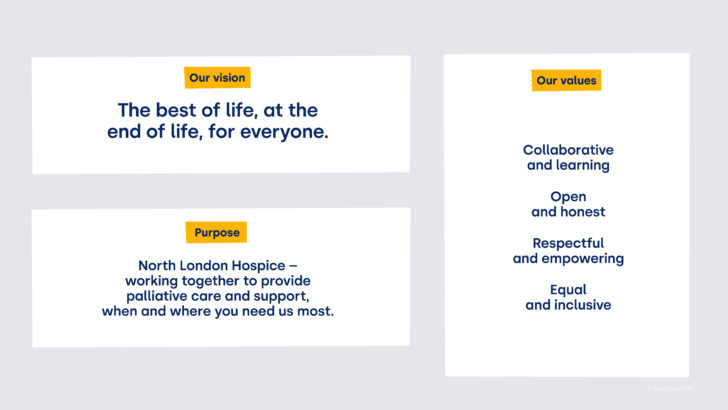
Their vision is ‘The best of life at the end of life for everyone’. Their purpose ‘Working together to provide palliative care and support when and where you need it most’ and their values ‘Collaborative and learning’, ‘Open and honest’, ‘Respectful and empowering’ and ‘Equal and inclusive’, gave us a foundation that we could start to build on. They had worked within their means and decided that, in this case, their budget was best used in the visual identity phase of the project.
The third part of the process was about what would work. We ran some audience workshops, and did some sector analysis to figure out what was expected, but also crucially, how we could create clear differentiation within the sector.
As mentioned before, budgets and timings were pretty tight, so while this might not have been as extensive as it could have been, you can be quite tactical here.

Even if you’re talking to quite a small number of people, think about getting the widest range of voices you can within that pool of people. Even if it’s only a handful, you can still start to gain some really valuable insights and make this a really meaningful exercise. That was definitely the case in our audience workshops with North London Hospice.
We asked our audiences purposefully pointed questions to spark conversation and discussion, and when we started talking about personality, we got some fantastic feedback. In particular, the response that we should be ‘less Jenny Bond a bit more Ruby Wax’. Don’t get me wrong. We love Jenny, but this was a really great summary of the kind of sentiment we were getting from our audience voices on how the brand should look and sound. And again, the type of insight that we might not have got if we’d been working in a silo and hadn’t started talking to our audiences.
This brings us to the final step, which is ‘Do’.
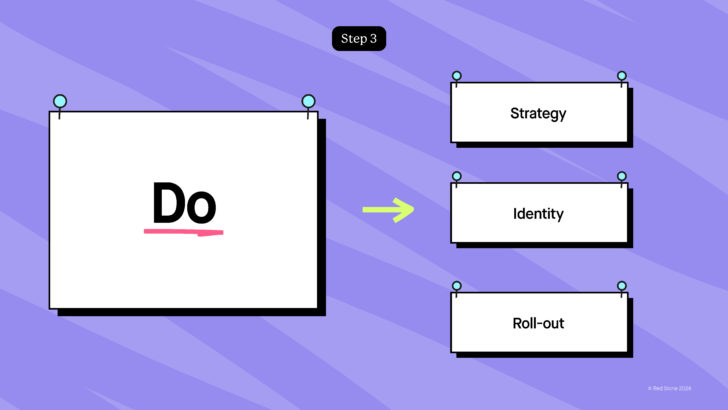
Step 3 – Do
This is where we put all that planning and reviewing into practice. And again, whilst brand development can be very complex, we want to try to simplify things into these three areas:
- Our strategy
- Our identity, which might be visual and verbal,
- Our rollout.
Rollout can sometimes be a bit of an afterthought in brand development, where we get so fixated on the challenges of changing the brand that we can forget to think about how we’re actually going to bring it to life. That brings us on to the last myth.

Myth 3: Brand development only works if we do it all in one go.
This is something that people can get really caught up in and feel like if they don’t change everything at once, they’re going to lose brand consistency and they might risk doing more harm than good. But the truth is, as long as it’s communicated clearly and you have a clear plan in mind, a phased roll out, or even a phased brand development, is totally legit. In fact you can actually turn it into a positive.
For instance, not replacing all your printed materials until the current ones are used up is not just cost effective, but it’s more sustainable as well. So there are ways we can manage that process, prioritising the most important touch points and working within your budgets. This is totally OK. The key is to have that clear roll out plan in place.
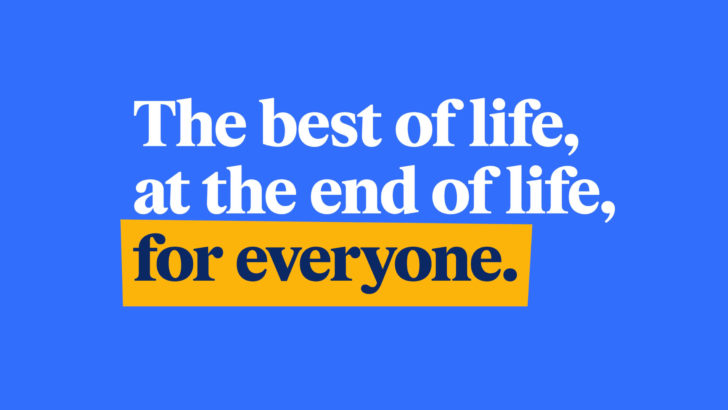
North London Hospice knew they needed to take a similar approach with their brand. They already had the strategic framework in place. These largely answered questions around what they do and why they do it, but we were missing a little bit of the 'how'. So it was all about taking that audience research to help us plug those strategic gaps and define a personality for them, without having to have the budget and time for a large scale strategy phase. This became the jumping off point for the new identity.
Being ‘bold’, being ‘different’, being ‘fizzy’, (which is a great word that doesn’t come up too often).
Coming from that audience research and combining that with a warmth and realism gave us a really good steer for how the brand should start to look and feel.

Having a good understanding of how and where your brand will actually show up also helps drive an efficient and effective creative development. For North London Hospice, we identified really quickly in the brand audit that the logo was going to do a lot of heavy lifting. It was going to be really visible on everything from nurses uniforms through to van delivery, social avatars and shop signage.
Paying particular attention to the marque, but also checking in on those original project objectives again – ease of use, but bold enough to build awareness. These became the cornerstones for everything we were doing. Is the brand easy to use by the internal teams? Is it going to give us that cut through we’re looking for?
The planning phase is super valuable when you get into the real detail of the project in making sure that we’re delivering something that is going to be useful, usable and effective.

Since we’ve delivered the brand, the team at North London Hospice have really embraced it. They’ve taken a phased approach to rolling it out. They’ve grown into the brand and been able to implement it across all their touch points in an incremental but planned way. And they’ve had time to get used to their new brand voice as they’ve done it. This phased approach has culminated in their first brand awareness campaign.
It’s been almost two years since the brand was introduced, which seems like a pretty long run up for a piece of work like this. But they’ve done it at a pace that was possible for them and managed to get everyone engaged – external audiences, internal audiences – and really start to understand what brand can do for them as an organisation. The brand campaign is also part of a broader effort to understand the impact of that brand on the organisation. Which brings us to the last step, which is to review again.
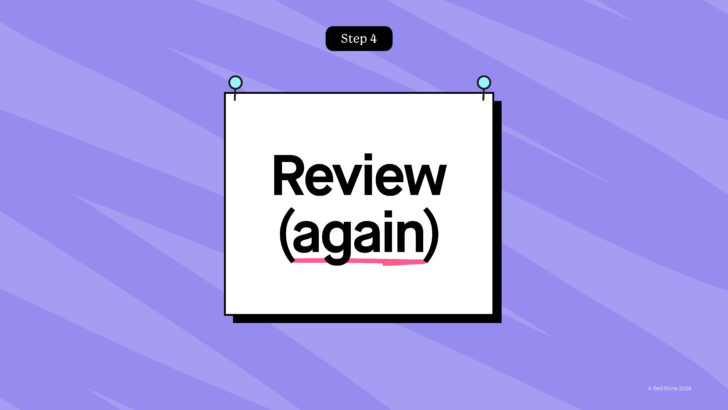
Step 4 – Review (again)
Checking against objectives and measuring our impact demonstrates the value of brand work, which can make further investment much easier to argue for. But it also offers some really valuable lessons for how we can start to improve things going forward – because that brand development and that rollout should only be the start of the journey.
We need to keep checking in and make sure that what we’re doing is always adding real value to the organisation.

Summary
So that is essentially it. Three-ish steps to break down the brand development process, remove a bit of noise and some of the confusion.
There are certain things that we're told we need to do to rebrand successfully, but recognising that we can adapt them to meet our needs, our resources and our means, whatever type of organisation, can change our approach to rebrand.
By Red Stone
Presented at CharityComms Brand Breakfast forum
2nd October 2024